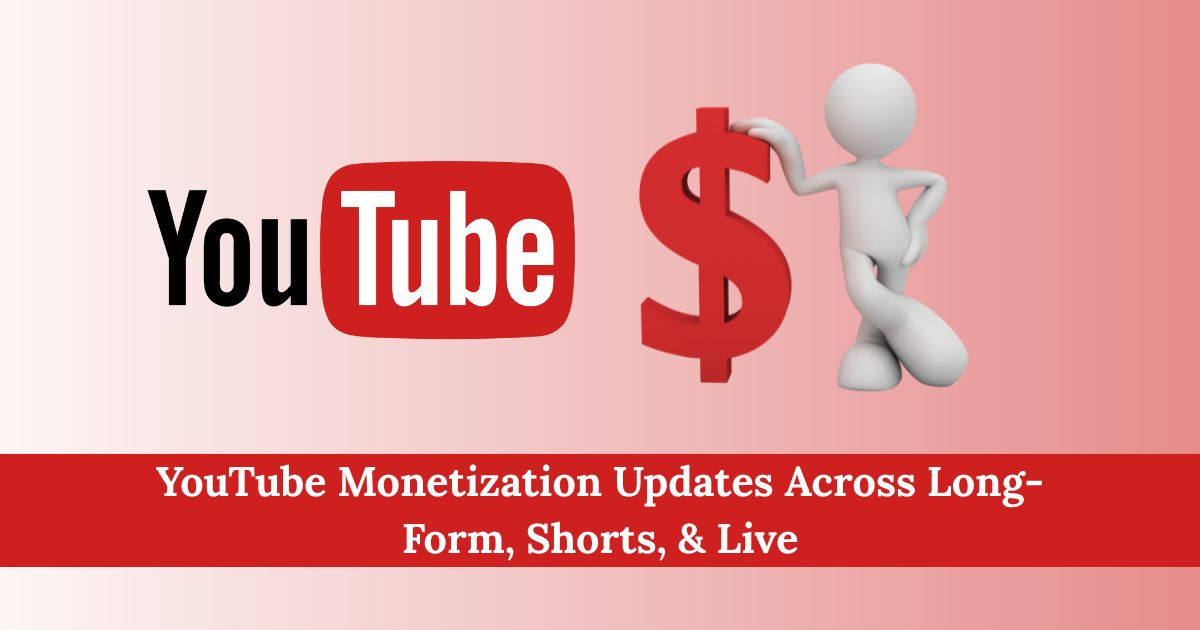YouTube has recently introduced several extensive changes to its monetization framework, impacting long-form videos, Shorts, and live broadcasts. Content creators, advertisers, and digital marketers on Online dot Marketing must study these YouTube Monetization Updates carefully to maximize revenue streams and align with YouTube’s evolving advertising ecosystem. This blog explains the latest updates in simple terms, covering dynamic sponsorships YouTube, brand linking in Shorts, AI product tagging YouTube, live streaming monetization & side-panel live ads YouTube, along with practical tips for creators and brands.
Why YouTube Monetization Updates Matter
YouTube is one of the most powerful platforms in 2025 for digital monetization, with more than 2.7 billion active users consuming content every month. Even small shifts in ad policies or monetization criteria can significantly alter creator earnings and advertiser ROI. The YouTube Monetization Updates are designed to expand options for creators while enabling advertisers to achieve better targeting, higher transparency, and improved tracking. For creators, understanding these updates is not optional; it’s necessary to sustain growth, diversify revenue sources, and avoid falling behind in an increasingly competitive content economy.
The changes go further than just showing ads. YouTube now includes smart AI features, easier sponsorship options, and tools for interactive live streams, together, these updates show a wider trend where creators can earn through a mix of ads, sponsorships, affiliate links, and product sales.
Long-Form Video Monetization Enhancements
Long-form content has always been a cornerstone of YouTube monetization, and the latest YouTube Monetization Updates make it more valuable. Enhancements include advanced mid-roll ad placement options, deeper audience analytics, and refined advertiser controls and for advertisers, the updates ensure better segmentation of viewer engagement metrics, making it possible to target audiences at different stages of content consumption.
The introduction of dynamic sponsorships YouTube allows brands to bid for sponsorship in specific segments of long videos, such as tutorials, episodic series, or reviews. Instead of a blanket sponsorship, advertisers can align with precise video sections that directly connect with their products.
Creators now benefit from:
- Greater flexibility in selecting ad formats, including custom integrations.
- Higher CPMs through improved targeting algorithms and placement logic.
- Deeper reporting insights for transparency and advertiser accountability.
- Integration with third-party ad tracking and measurement tools.
- More control over brand associations, reducing conflicts between sponsorships.
Shorts Monetization & Brand Linking
Short-form content continues to dominate mobile and younger audiences. A core YouTube Monetization Update introduces brand linking in Shorts, allowing creators to connect branded campaigns directly with short-form videos. This goes far beyond ad-revenue payouts from the Shorts Fund by introducing a sponsorship-first model and for smaller creators, this is especially valuable, as short, viral content often drives more engagement than long-form videos.
Advantages of brand linking in Shorts include:
- Seamless integration of sponsor mentions and clickable brand links.
- Stronger user engagement through embedded, non-disruptive branding.
- Easier tracking of campaign performance via Google Ads Manager.
- New opportunities for nano & micro creators to monetize quickly.
- Integration with dynamic sponsorships YouTube, offering hybrid monetization.
With brand linking in Shorts, advertisers gain continuous visibility on fast-consumed mobile content, while creators unlock a flexible new revenue channel aligned with current consumption trends.
AI Product Tagging YouTube for Commerce Growth
YouTube’s push into e-commerce is supported by AI product tagging YouTube, a standout feature in the latest monetization rollouts and this technology uses artificial intelligence to detect and tag products shown in video frames, linking them to purchase options or affiliate integrations.
Benefits of AI product tagging YouTube include:
- Automated detection of products with catalog matching.
- Reduced manual work for creators in affiliate setups.
- Higher accuracy in product linking for increased CTR & conversions.
- Deeper analytics for advertisers on viewer purchase intent.
- Multi-category support, from apparel & beauty to electronics.
For creators, AI product tagging YouTube means building automated affiliate income without extensive manual effort. For brands, it ensures scalable and accurate product exposure across a wide variety of content types and over time, this could evolve into a primary source of commerce-driven monetization on the platform.
Live Streaming Monetization Enhancements
Live video continues to grow, particularly for gaming, events, and influencer-hosted launches. YouTube Monetization Updates introduce expanded live streaming monetization opportunities. Beyond Super Chats, creators now access tiered supporter subscriptions, interactive branded overlays, and exclusive audience perks.
New tools within live streaming monetization:
- Tiered supporter badges and differentiated subscription levels.
- Sponsored chat highlights with brand integration for visibility.
- Real-time product tagging powered by AI product tagging YouTube.
- Integration of affiliate commerce during live campaigns.
- Cross-platform linking for sponsors during major live events.
These enhancements transform live streaming into a hybrid monetization channel combining traditional ad formats, direct fan contributions, and branded integrations, for advertisers, the ability to connect with audiences during high-attention live events ensures maximum visibility.
Read Also – How to Use Google Nano Banana in Your AI Animation Workflow
Side-Panel Live Ads on YouTube
Another innovative update is side-panel live ads YouTube, which introduces persistent ads alongside live streams and these ad units maintain brand presence without disrupting the viewing experience.
Key aspects of side-panel live ads YouTube:
- Non-disruptive static or interactive ad placements.
- Better viewer retention since ads do not interrupt playback.
- Strong integration with Google Ads measurement tools.
- Compatibility across both desktop & mobile live sessions.
- Ability for sponsors to pair side-panel ads with dynamic sponsorships YouTube.
Integration of Dynamic Sponsorships YouTube Across Formats
Perhaps the most transformative of the YouTube Monetization Updates is the system-wide introduction of dynamic sponsorships YouTube. These sponsorships adapt across all formats—long-form, Shorts, and live streams. Instead of static deals, advertisers can now bid dynamically for campaigns that follow viewers across video categories.
Practical applications include:
- A beauty brand dynamically sponsoring reviews using AI product tagging YouTube.
- A gaming company activating live tournament branding via side-panel live ads YouTube.
- Lifestyle brands connecting directly with audiences via brand linking in Shorts.
Read Also – Google Fixes Reduced Crawling Issue Affecting Some Websites
Technical Considerations for Advertisers & Creators
To maximize benefits from the YouTube Monetization Updates, creators & marketers should focus on technical strategy:
- Metadata optimization: Titles, descriptions, and tags must align with targeted monetization models.
- Audience segmentation: Analyze viewer data to connect sponsorships with audience behavior.
- Ad placement testing: Compare outcomes from mid-rolls vs. side-panel live ads YouTube.
- Affiliate automation: Use AI product tagging YouTube to enable scalable commerce integrations.
- Campaign A/B testing: Validate performance of dynamic vs. static sponsorships.
Read Also – Google Search Console Achievements Report
Conclusion
The latest YouTube Monetization Updates represent a shift from simple ad-based models toward hybrid, AI-powered, and interactive monetization methods. Features such as dynamic sponsorships YouTube, brand linking in Shorts, AI product tagging YouTube, live streaming monetization, and side-panel live ads YouTube create new opportunities for creators while giving advertisers stronger control over spend and targeting.
On Online dot Marketing, creators are encouraged to adopt multi-format monetization strategies, run regular performance reviews, and remain agile in testing. Advertisers gain more accurate insights into ROI, while creators unlock diversified revenue streams. Early adopters of the YouTube Monetization Updates will secure stronger financial foundations in the evolving digital content economy.





